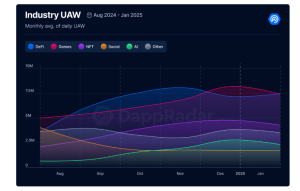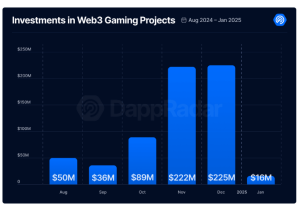Communities play a vital role in driving change across various industries, including the Web3 Gaming industry. The collective support of users, through active participation and collaboration, is key to accelerating innovation and expanding the adoption of new technologies. Additionally, crowdfunding mechanisms allow gaming projects to raise funds in a decentralized manner, empowering the community to help shape the direction of development.
In this article, AllSpark Research cites a report from blockchain analytics platform DappRadar, which reveals a surge in on-chain activity in the Web3 Gaming sector, highlighting the power of community and the tangible impact of industry shifts on users.
Rapid Growth of Web3 Gaming Interest in One Year
According to the DappRadar report, on-chain activity tripled in January 2025 compared to the same period in 2024. The blockchain gaming industry continues to be a major driver in the decentralized application (dApp) ecosystem, with the number of daily Unique Active Wallets (UAW) reaching 7 million in January this year. This figure reflects a significant 386% growth compared to January 2024, with total recorded UAWs across the ecosystem reaching 26.7 million.

Key factors driving this growth include advancements in Layer-2 technology, the development of token economies, and collaborations with AAA game developers like Gunzilla Games through the Off The Grid project. Furthermore, the widespread adoption of play-to-earn models and the integration of blockchain features that enhance user experience have accelerated innovation within the ecosystem. The support of an active community has also been a crucial catalyst in expanding the reach of new gaming projects.
Pillars of Growth: Factors Strengthening the Community
A strong community grows from a solid foundation — mutual support, shared goals, and a spirit of collaboration. Several standout players are shaping the industry, supported by factors that strengthen communities in the Web3 Gaming space.

a. Digital Connections and Interaction Platforms
Social media, forums, and Discord servers play a crucial role in connecting community members in the Web3 Gaming industry. On these platforms, users can share information, discuss, and collaborate without geographical limitations. Online forums and social media enable in-depth discussions, while Discord, with its server and channel features, facilitates real-time communication via text, voice, and video. As a result, community members create a strong sense of togetherness and solidarity.
A concrete example of this concept can be seen in the blockchain gaming community like World of Dypians. This game combines Web3 innovation with an immersive gaming experience, connecting innovators and gaming enthusiasts in a rapidly growing ecosystem. This Web3 gaming project consistently builds strong communication networks across social media platforms and community forums.
b. User Empowerment Through Ownership
Blockchain technology enables community members to own a part of the project, reinforcing their sense of belonging. A clear example of this is KGeN, a game that empowers users through ownership. KGeN features Proof of Gamer (POG) NFTs, where players can own and control their gaming identity across multiple platforms and blockchains.
This feature gives players real ownership of their profiles, which evolve dynamically based on their gaming activities. Additionally, players receive direct benefits, such as adaptive AI avatars, bigger rewards for completing missions, and rKGEN tokens that can be exchanged 1:1 with KGEN tokens in the future.
c. Collaboration and Co-Creation
ERAGON is an example of a successful project where the community contributes to feature or content development. ERAGON demonstrates elements of collaboration and co-creation through its “Meme Land” feature and community contests. By hosting competitions that actively involve users in discussions, ERAGON encourages community members to interact, share ideas, and create content together. Rewards in the form of EGON tokens and exclusive gift codes further motivate players to contribute, strengthening the sense of community and building an ecosystem that grows through creativity and collective participation.
Real Impact: Industry Shifts Driven by Communities
Communities have proven that local collaboration can drive industry transformation through innovation and the integration of local wisdom with modern technology. These initiatives shift production paradigms, diversify products, and open up new job opportunities, realizing tangible progress.
a. User-Driven Innovation
Communities can provide feedback and guide developers to create relevant solutions. An example is Off The Grid, which excels in user-driven innovation. This game consistently keeps players engaged by introducing new, exciting content, such as exclusive skins from esports legends and innovative items like the BounceBomber cyberlimb. Through free and premium tier mechanisms and Battle Pass challenges that allow players to earn various rewards, developers show responsiveness to players’ desires for a more personalized and diverse gaming experience.’
b. Project Sustainability
A loyal community can serve as a stable foundation for projects to survive market challenges. Age of Dino demonstrates potential in building a loyal community to support project sustainability. Features like dinosaur ownership and alliance wars strengthen player interactions, creating a tight-knit community bond. Through a combination of rewards and social activities, Age of Dino can maintain a stable player base, helping the project endure market dynamics.
c. Crowdfunding as an Alternative Funding Option

As communities grow, investment opportunities also increase, supported by clear evidence of engagement and market potential. Throughout 2024, DappRadar data recorded total investments in blockchain games and metaverse projects reaching $1.8 billion, a 38% year-over-year decline. Beyond traditional investment options, the Web3 gaming industry is also open to alternative funding sources, such as crowdfunding.
Crowdfunding has become an innovative way for game developers to raise funds and build a solid community from the early stages of development. Unlike traditional crowdfunding, Web3 leverages blockchain technology to provide transparency, digital ownership, and attractive incentives for project supporters.
KGeN is linked to a crowdfunding-like mechanism through the launch of rKGEN, a non-transferable reward token that can be redeemed 1:1 for KGEN tokens in the future. This mechanism allows players to accumulate tokens as a reward for their participation, which can then contribute to the game ecosystem’s development.
Conclusion: Community as the Driving Force of Change
Communities have become the primary driving force transforming the Web3 gaming industry by facilitating innovation, collaboration, and user empowerment. Through digital connectivity, co-creation collaboration, and blockchain-based ownership mechanisms, communities not only accelerate the adoption of new technologies but also create an inclusive and sustainable ecosystem.
This collective spirit encourages developers to respond dynamically to player needs, opening up alternative funding opportunities like crowdfunding. This underscores the vital role of communities in steering significant changes in the blockchain gaming realm. The hope for the future is that community strengthening will continue to be the main driving force of digital transformation, integrating active collaboration, technological innovation, and a shared spirit of progress.

